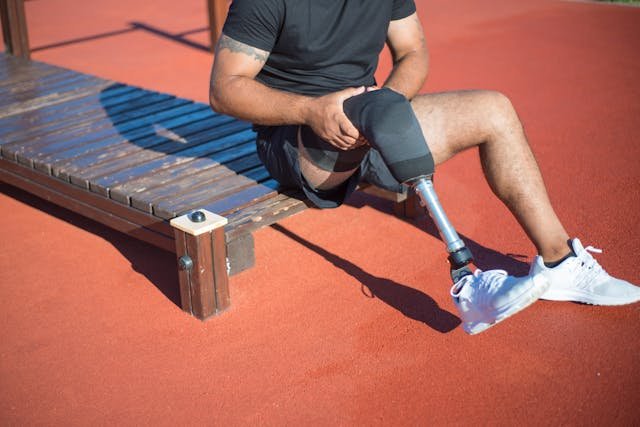After an amputation, many people think their journey with a prosthetic begins and ends with one permanent limb. But that’s not the case. Before receiving a final prosthesis, most users first go through an important and often overlooked phase—the temporary prosthetic stage. This stage plays a vital role in preparing the body and mind for long-term use. It helps shape the residual limb, improve balance, build strength, and restore independence gradually and safely.
At Robobionics, we’ve seen how much of a difference a well-made temporary prosthesis can make in someone’s recovery. It’s not just a stepping stone—it’s a bridge between healing and lifelong movement. In this article, we’ll explain how temporary prosthetics work, why they matter, and how they support a smoother transition into using a permanent prosthetic limb.
Understanding What a Temporary Prosthetic Is
A temporary prosthetic is the first artificial limb worn after amputation. It is usually given once the surgical wound has healed and swelling has reduced. While it may look similar to a permanent prosthetic, it serves a very different purpose. It’s designed to support recovery, not replace the limb forever.
Preparing the Residual Limb for a Final Fit

In the weeks after surgery, the residual limb goes through many changes. It shrinks, shapes, and becomes more stable. A permanent prosthetic can’t be made during this stage because the limb is still adjusting. A temporary prosthetic gives the body time to settle while still allowing movement and function.
This early use also helps the skin and muscles adapt to wearing a device. Without it, the limb might become stiff, weak, or less responsive. By wearing a temporary prosthesis, the user helps guide their limb into a better condition for permanent socket design.
At Robobionics, we carefully time the introduction of a temporary prosthesis, ensuring that healing is well underway and that the limb is ready for controlled pressure and movement.
Supporting Early Standing and Mobility
A big part of recovery after amputation is regaining independence. The temporary prosthetic allows users to begin standing, shifting weight, and even walking with assistance. These movements help strengthen the muscles, protect joint flexibility, and improve blood flow.
Most importantly, it helps the user build confidence. When someone takes their first step after limb loss, it’s a powerful moment. The temporary prosthesis provides enough stability to allow this without waiting for the final limb.
At Robobionics, we use lightweight materials and soft liners in our temporary designs to make early mobility easier and more comfortable. Every step is supported by our rehab team to ensure safety.
Giving Time to Learn and Adapt
Adjusting to a prosthetic takes time—not just physically, but mentally. Learning how to balance, walk, sit, and move again with a prosthetic involves practice. The temporary device gives users space to make mistakes, learn their body again, and understand what works best for them.
By the time they are ready for their permanent limb, they have already mastered basic skills. This makes the transition smoother and less stressful. It also allows them to give feedback about comfort, fit, and design, which helps in building a better final device.
Robobionics encourages open communication during this phase so every permanent limb is made with personal input and practical experience.
Supporting Limb Shaping and Socket Design
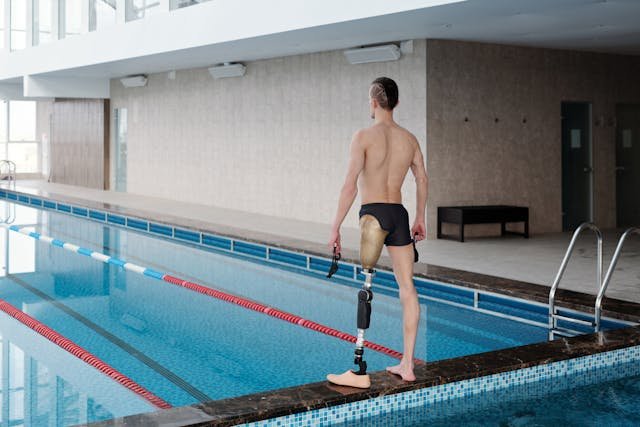
One of the main goals of using a temporary prosthetic is to help shape the residual limb. This directly affects how well the permanent socket will fit. If the limb isn’t properly shaped and strengthened, the final prosthetic may feel loose, tight, or uncomfortable.
Helping the Limb Take Its Final Shape
After surgery, the limb is usually swollen and soft. Over time, it shrinks and firms up. But without wearing a prosthetic or using compression, this process can take longer or result in an uneven shape. A temporary prosthetic encourages healthy shaping by applying controlled, even pressure.
This pressure helps guide the limb into a rounded, stable shape that makes future socket fitting easier. A well-shaped limb also supports better weight distribution, which leads to more comfort and less risk of skin problems later.
At Robobionics, our temporary sockets are designed to be adjustable so they can match the limb’s changes over time. We monitor the shaping process closely with regular scans and follow-up appointments.
Preventing Socket Fit Problems Later
If the limb is misshapen or inconsistent in size, it becomes harder to design a final socket that fits well. An uneven limb might lead to pressure points, gaps, or slippage. These issues can cause pain or limit how long someone can wear their prosthetic each day.
By using a temporary prosthetic during the healing stage, we can avoid these problems. The socket supports the limb as it changes, and the adjustments help fine-tune the fit before the final prosthesis is even made.
At Robobionics, we work with users to track comfort and pressure while wearing their temporary limb. This helps us design a final socket that truly fits their body and lifestyle.
Creating a Custom Fit with Real-Life Feedback
The temporary prosthetic also acts as a learning tool. It shows what kind of socket shape, suspension system, or alignment works best for the user. With this real-life feedback, the permanent prosthetic can be made more precise and more personalized.
Users may discover that they prefer a certain liner, or that one kind of ankle setup feels better than another. This information can only come from actually using a prosthetic in everyday life, not just from measurements.
Robobionics uses this feedback to make each final limb more comfortable and effective. Our goal is always to design a prosthetic that fits the user’s body and supports their daily needs.
Building Strength and Stability for Long-Term Use
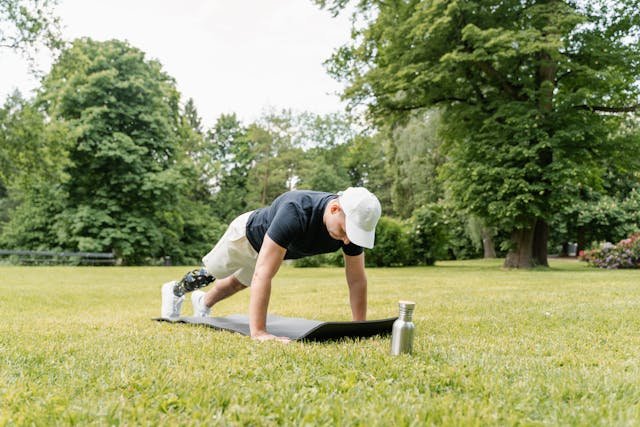
Wearing a prosthetic limb requires strength—not just in the limb itself, but throughout the body. The hips, back, core, and opposite leg all play a role in balance, walking, and posture. A temporary prosthetic gives users the time and tools to build this strength gradually. This preparation is key to handling the demands of a permanent prosthetic with more comfort and less fatigue.
Training the Body to Move with a Prosthetic
After amputation, the body’s natural movements change. Walking, standing, and sitting now require a different pattern. Muscles that were not used before suddenly need to take on new tasks. The temporary prosthetic allows users to train with these new movements safely. It gives the body a chance to adjust step by step.
Therapists guide users through exercises that teach weight shifting, step control, and balance. These movements help retrain the brain and muscles to work together again. The more comfortable a user becomes with these patterns, the easier the transition to a permanent limb will be.
At Robobionics, we include physiotherapy support in every temporary fitting plan. Our goal is not just to fit a device—but to help the user move well with it.
Preventing Overuse and Muscle Imbalance
When someone first starts walking with a prosthetic, it’s common to favor one side or lean in certain ways. If this continues, it can cause long-term problems like joint pain, back strain, or uneven posture. These issues often show up after the permanent limb is fitted, but they begin during the temporary phase.
With a temporary prosthetic, therapists can monitor and correct these habits early. They can guide users to strengthen both sides of the body evenly. This helps avoid overuse of one leg or slouching during standing and walking.
Robobionics encourages slow, steady progress with guided exercises. We make sure each user builds balanced strength that supports them now and in the future.
Creating a Foundation for Long-Term Comfort
Comfort with a prosthetic doesn’t come from the device alone—it comes from how the body supports it. When a user is strong, balanced, and well-trained, they are more likely to feel good in their final prosthetic. They are also less likely to need major socket changes or take long breaks from using the limb.
The temporary prosthetic is the training tool that creates this foundation. It gives users the chance to build habits that will support comfort for years to come. Every small improvement—like walking a little straighter or standing a little longer—adds up over time.
At Robobionics, we see the temporary stage as a physical investment. It prepares the user’s body to thrive in the permanent phase, with less effort and more ease.
Building Emotional Readiness and Confidence Through Early Use

While much of prosthetic recovery focuses on the body, the emotional side is just as important. Adjusting to life after amputation is a major change. Feelings of loss, fear, or doubt are common. A temporary prosthetic plays a vital role in supporting the emotional recovery process. It gives users a way to reconnect with their body and begin imagining a future where movement is possible again.
Rebuilding Confidence Step by Step
After surgery, many users feel uncertain. They may wonder if they’ll ever walk again or return to their normal routines. The temporary prosthetic offers proof that progress is possible. Just being able to stand up or take a few steps brings back a sense of ability and strength.
Each day with the temporary prosthesis brings small wins. Putting it on without help, walking a short distance, or getting through the day with less discomfort—these small moments build confidence. That confidence makes it easier to move forward toward a permanent prosthetic with hope instead of fear.
At Robobionics, we celebrate these milestones with every user. We know that progress is not always fast, but it is always meaningful.
Helping Users Feel More in Control
Recovery can feel overwhelming. There are doctor visits, healing routines, and lifestyle changes. In the middle of all this, a temporary prosthetic offers something powerful—control. It gives users a way to take action in their own healing. They’re not just waiting; they’re moving.
When someone puts on their prosthetic and walks to the door instead of being helped, it shifts how they see themselves. They go from being a patient to being a person in motion. This change in mindset helps reduce anxiety and boosts motivation for therapy and self-care.
Robobionics designs its temporary prosthetics to be easy to use, so that users feel empowered from the start. We also provide emotional support and coaching throughout the process.
Reducing the Shock of Transition to a Permanent Limb
Jumping straight from healing to a permanent prosthetic can feel overwhelming. If the body and mind aren’t prepared, the user may struggle to adapt. They may feel discomfort, frustration, or disappointment. The temporary prosthetic eases this transition.
By the time the permanent limb is ready, the user already knows how to walk, how to wear a socket, and how to care for their limb. They have built strength, learned balance, and faced challenges in a safe, guided environment. This makes the change feel less like a leap—and more like a natural next step.
At Robobionics, we make sure our users are emotionally and physically ready for the permanent limb. We use the temporary stage to build not just skill—but self-trust.
Knowing When It’s Time to Transition to a Permanent Limb
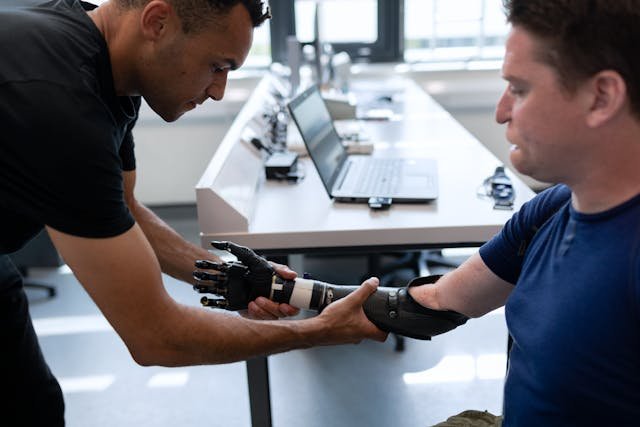
One of the most common questions users have is: “When will I be ready for my permanent prosthetic?” There’s no single answer, because every person heals and adapts at a different pace. But there are clear signs that show when the body and mind are ready. The temporary prosthetic helps make this decision clearer and more informed.
Watching for a Stable Residual Limb Shape
The shape and size of the residual limb must settle before a permanent socket can be made. In the early weeks and months, swelling decreases and the tissues adjust. If a permanent socket is made too early, it won’t fit well for long. This could lead to pressure spots, discomfort, or the need for repeated socket changes.
With a temporary prosthetic, users can wear a socket while their limb continues to change. Prosthetists can make small adjustments or change liners to match this process. Once the limb shape stops changing as much, it becomes easier to design a final prosthetic that fits well and lasts longer.
At Robobionics, we monitor each user’s limb changes closely. We use regular measurements and feedback from the user to decide the right time to move forward.
Achieving Movement Goals with the Temporary Prosthetic
Before transitioning to a permanent prosthetic, users should be able to perform basic daily movements with their temporary one. This includes putting it on and off, walking short distances, standing with balance, and sitting or getting up without help. These are signs that the user’s body is strong and stable enough for full-time use.
Therapists and prosthetists work together during this stage to guide training and track progress. They help correct movement patterns, build strength in the right muscles, and ensure good posture and technique. The better the movement with the temporary limb, the smoother the switch to a permanent one.
Robobionics helps users set clear goals during the temporary stage—then supports them until those goals are met. This creates a smooth path from practice to permanence.
Feeling Mentally Prepared for the Next Step
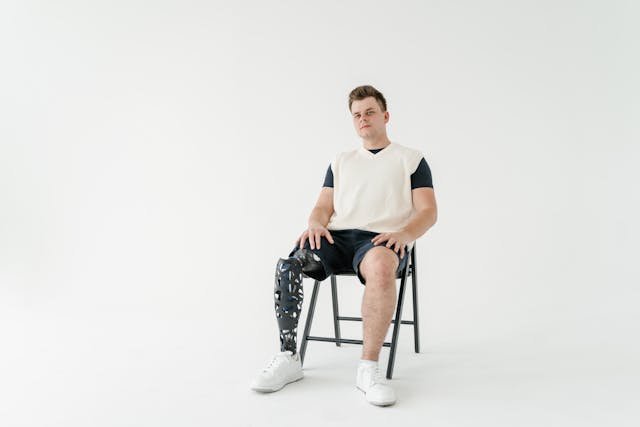
Physical readiness is important—but mental readiness matters just as much. Some users may be nervous about switching to a new device. They may worry that it won’t feel the same or that they’ll have to start over. Others might feel unsure about leaving the familiar behind.
That’s why the emotional part of the transition must be supported. When a user feels confident in how they move, understands how the prosthetic works, and trusts their care team, they are more likely to feel ready for a permanent limb. Open communication, reassurance, and shared decision-making all help make the change a positive one.
At Robobionics, we never rush the move to a permanent prosthetic. We help users prepare on every level—so they’re not just receiving a new limb, but embracing the life that comes with it.
Conclusion
The journey from amputation to independence doesn’t begin with the final prosthetic—it begins much earlier, with the temporary limb. This important phase gives the body time to heal, the mind space to adjust, and the user a chance to learn, grow, and move again. Temporary prosthetics are more than placeholders. They are essential tools that shape not just the limb, but the entire recovery process.
With the right guidance, a temporary prosthetic helps users build strength, correct posture, protect the skin, and understand what their body needs. It prepares the limb for a better socket fit and prepares the user for a life of confident movement. Perhaps most importantly, it brings back hope during a time when many feel unsure about what’s next.
At Robobionics, we believe in supporting every step of that journey—from the first fitting to the final transition. Our team works closely with users, families, and therapists to create a recovery plan that feels personal, empowering, and clear. Because we know that every strong future begins with a steady first step.
If you’re preparing for prosthetic care or want to understand how temporary limbs can support your recovery, connect with Robobionics today.



